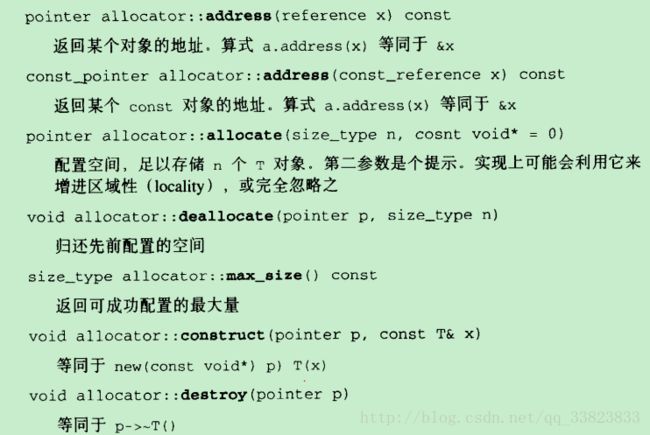STL源码剖析读书笔记2
空间适配器allocator
为什么不说allocator是内存适配器而是空间适配器,原因就是你可以写
allocat直接向硬盘取空间。
allocator标准接口
设计一个简单的空间配置器JJ::allocator
_STD_BEGIN
// 这里是内存分配
// TEMPLATE FUNCTION _Allocate
template<class _Ty> inline
_Ty _FARQ *_Allocate(_SIZT _Count, _Ty _FARQ *)
{ // allocate storage for _Count elements of type _Ty
void *_Ptr = 0;
if (_Count <= 0)
_Count = 0;
else if (((_SIZT)(-1) / sizeof (_Ty) < _Count)
|| (_Ptr = ::operator new(_Count * sizeof (_Ty))) == 0)
_THROW_NCEE(bad_alloc, 0);
return ((_Ty _FARQ *)_Ptr);
}
// 使用 placement new 进行对象的拷贝构造放置
// TEMPLATE FUNCTION _Construct
template<class _Ty1,
class _Ty2> inline
void _Construct(_Ty1 _FARQ *_Ptr, _Ty2&& _Val)
{ // construct object at _Ptr with value _Val
void _FARQ *_Vptr = _Ptr;
::new (_Vptr) _Ty1(_STD forward<_Ty2>(_Val));
}
// 使用 placement new 进行对象的默认构造放置
template<class _Ty1> inline
void _Construct(_Ty1 _FARQ *_Ptr)
{ // construct object at _Ptr with default value
void _FARQ *_Vptr = _Ptr;
::new (_Vptr) _Ty1();
}
// 对象销毁(析构函数)
// TEMPLATE FUNCTION _Destroy
template<class _Ty> inline
void _Destroy(_Ty _FARQ *_Ptr)
{ // destroy object at _Ptr
_Ptr->~_Ty();
}
// 内嵌字符串类型不用析构,特化版本供优化使用
template<> inline
void _Destroy(char _FARQ *)
{ // destroy a char (do nothing)
}
template<> inline
void _Destroy(wchar_t _FARQ *)
{ // destroy a wchar_t (do nothing)
}
#ifdef _NATIVE_WCHAR_T_DEFINED
template<> inline
void _Destroy(unsigned short _FARQ *)
{ // destroy a unsigned short (do nothing)
}
#endif /* _NATIVE_WCHAR_T_DEFINED */
// 根据指针类型选择是否为 POD 数据类型
// TEMPLATE FUNCTION _Destroy_range
template<class _Alloc> inline
void _Destroy_range(typename _Alloc::pointer _First,
typename _Alloc::pointer _Last, _Alloc& _Al)
{ // destroy [_First, _Last)
_Destroy_range(_First, _Last, _Al, _Ptr_cat(_First, _Last));
}
// 非 POD 数据类型需要显示调用析构函数
template<class _Alloc> inline
void _Destroy_range(typename _Alloc::pointer _First,
typename _Alloc::pointer _Last, _Alloc& _Al,
_Nonscalar_ptr_iterator_tag)
{ // destroy [_First, _Last), arbitrary type
for (; _First != _Last; ++_First)
_Dest_val(_Al, _First);
}
// POD 数据类型不需要调用析构函数
template<class _Alloc> inline
void _Destroy_range(typename _Alloc::pointer _First,
typename _Alloc::pointer _Last, _Alloc& _Al,
_Scalar_ptr_iterator_tag)
{ // destroy [_First, _Last), scalar type (do nothing)
}
// TEMPLATE FUNCTION addressof
template<class _Ty> inline
_Ty * addressof(_Ty& _Val)
{ // return address of _Val
return ((_Ty *) &(char&)_Val);
}
// TEMPLATE CLASS _Allocator_base
template<class _Ty>
struct _Allocator_base
{ // base class for generic allocators
typedef _Ty value_type;
};
// 偏特化,去除 const 属性
// TEMPLATE CLASS _Allocator_base
template<class _Ty>
struct _Allocator_base<const _Ty>
{ // base class for generic allocators for const _Ty
typedef _Ty value_type;
};
// TEMPLATE CLASS _ALLOCATOR
template<class _Ty>
class _ALLOCATOR
: public _Allocator_base<_Ty>
{ // generic allocator for objects of class _Ty
public:
typedef _Allocator_base<_Ty> _Mybase;
typedef typename _Mybase::value_type value_type;
typedef value_type _FARQ *pointer;
typedef value_type _FARQ& reference;
typedef const value_type _FARQ *const_pointer;
typedef const value_type _FARQ& const_reference;
typedef _SIZT size_type;
typedef _PDFT difference_type;
// 由于在STL容器中allocator是以模板参数传入的,而对于节点型容器,
template<class _Other>
struct rebind
{ // convert this type to _ALLOCATOR<_Other>
typedef _ALLOCATOR<_Other> other;
};
pointer address(reference _Val) const
{ // return address of mutable _Val
return ((pointer) &(char&)_Val);
}
const_pointer address(const_reference _Val) const
{ // return address of nonmutable _Val
return ((const_pointer) &(char&)_Val);
}
_ALLOCATOR() _THROW0()
{ // construct default allocator (do nothing)
}
_ALLOCATOR(const _ALLOCATOR<_Ty>&) _THROW0()
{ // construct by copying (do nothing)
}
// 这里使用了 Coercion by Member Template 惯用法
template<class _Other>
_ALLOCATOR(const _ALLOCATOR<_Other>&) _THROW0()
{ // construct from a related allocator (do nothing)
}
// 这里使用了 Coercion by Member Template 惯用法
template<class _Other>
_ALLOCATOR<_Ty>& operator=(const _ALLOCATOR<_Other>&)
{ // assign from a related allocator (do nothing)
return (*this);
}
// 内存释放
void deallocate(pointer _Ptr, size_type)
{ // deallocate object at _Ptr, ignore size
::operator delete(_Ptr);
}
// 内存分配
pointer allocate(size_type _Count)
{ // allocate array of _Count elements
return (_Allocate(_Count, (pointer)0));
}
pointer allocate(size_type _Count, const void _FARQ *)
{ // allocate array of _Count elements, ignore hint
return (allocate(_Count));
}
void construct(pointer _Ptr, const _Ty& _Val)
{ // construct object at _Ptr with value _Val
_Construct(_Ptr, _Val);
}
// placement new
void construct(pointer _Ptr, _Ty&& _Val)
{ // construct object at _Ptr with value _Val
::new ((void _FARQ *)_Ptr) _Ty(_STD forward<_Ty>(_Val));
}
template<class _Other>
void construct(pointer _Ptr, _Other&& _Val)
{ // construct object at _Ptr with value _Val
::new ((void _FARQ *)_Ptr) _Ty(_STD forward<_Other>(_Val));
}
// 对象销毁
void destroy(pointer _Ptr)
{ // destroy object at _Ptr
_Destroy(_Ptr);
}
_SIZT max_size() const _THROW0()
{ // estimate maximum array size
_SIZT _Count = (_SIZT)(-1) / sizeof (_Ty);
return (0 < _Count ? _Count : 1);
}
};
[1] placement new是重载operator new的一个标准、全局的版本,它不能被自定义的版本代替(不像普通的operator new和operator delete能够被替换成用户自定义的版本)。
它的原型如下:
void *operator new( size_t, void *p ) throw() { return p; }使用方法如下:
- 缓冲区提前分配
可以使用堆的空间,也可以使用栈的空间,所以分配方式有如下两种:
class MyClass {…};
char *buf=new char[N*sizeof(MyClass)+ sizeof(int) ] ;
或者char buf[N*sizeof(MyClass)+ sizeof(int) ];
- 对象的构造
MyClass * pClass=new(buf) MyClass;
- 对象的销毁
一旦这个对象使用完毕,你必须显式的调用类的析构函数进行销毁对象。但此时内存空间不会被释放,以便其他的对象的构造。
pClass->~MyClass();
- 内存的释放
如果缓冲区在堆中,那么调用delete[] buf;进行内存的释放;如果在栈中,那么在其作用域内有效,跳出作用域,内存自动释放.
[2] size_t size=sizeof(i);//用sizeof操作得到变量i的类型的大小
ptrdiff_t diff=p2-p1;//指针的减法可以计算两个指针之间相隔的元素个数[3]exit用在main内的时候无论main是否定义成void返回的值都是有效的,并且exit不需要考虑类型,exit⑴等价于return ⑴


